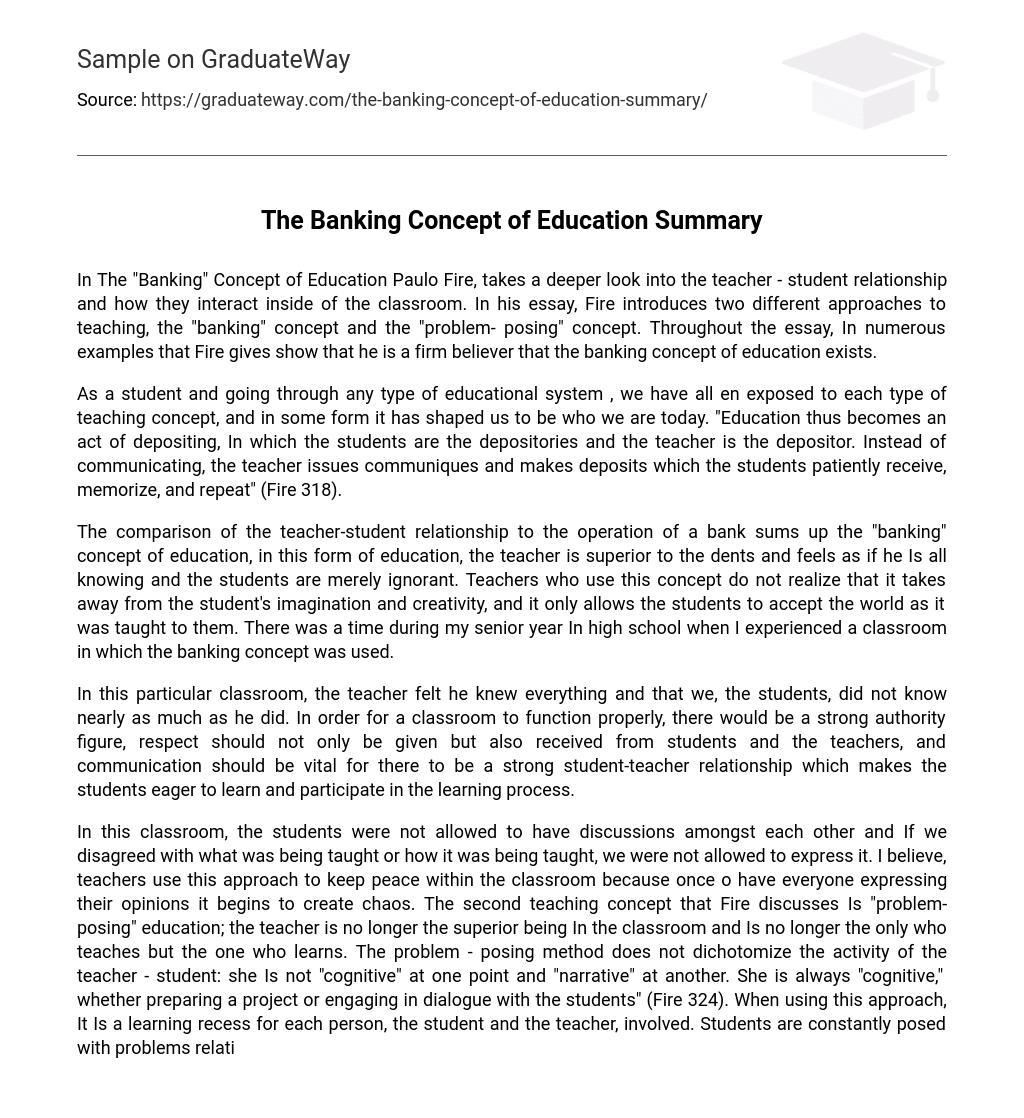In The “Banking” Concept of Education Paulo Fire, takes a deeper look into the teacher – student relationship and how they interact inside of the classroom. In his essay, Fire introduces two different approaches to teaching, the “banking” concept and the “problem- posing” concept. Throughout the essay, In numerous examples that Fire gives show that he is a firm believer that the banking concept of education exists.
As a student and going through any type of educational system , we have all en exposed to each type of teaching concept, and in some form it has shaped us to be who we are today. “Education thus becomes an act of depositing, In which the students are the depositories and the teacher is the depositor. Instead of communicating, the teacher issues communiques and makes deposits which the students patiently receive, memorize, and repeat” (Fire 318).
The comparison of the teacher-student relationship to the operation of a bank sums up the “banking” concept of education, in this form of education, the teacher is superior to the dents and feels as if he Is all knowing and the students are merely ignorant. Teachers who use this concept do not realize that it takes away from the student’s imagination and creativity, and it only allows the students to accept the world as it was taught to them. There was a time during my senior year In high school when I experienced a classroom in which the banking concept was used.
In this particular classroom, the teacher felt he knew everything and that we, the students, did not know nearly as much as he did. In order for a classroom to function properly, there would be a strong authority figure, respect should not only be given but also received from students and the teachers, and communication should be vital for there to be a strong student-teacher relationship which makes the students eager to learn and participate in the learning process.
In this classroom, the students were not allowed to have discussions amongst each other and If we disagreed with what was being taught or how it was being taught, we were not allowed to express it. I believe, teachers use this approach to keep peace within the classroom because once o have everyone expressing their opinions it begins to create chaos. The second teaching concept that Fire discusses Is “problem-posing” education; the teacher is no longer the superior being In the classroom and Is no longer the only who teaches but the one who learns. The problem – posing method does not dichotomize the activity of the teacher – student: she Is not “cognitive” at one point and “narrative” at another. She is always “cognitive,” whether preparing a project or engaging in dialogue with the students” (Fire 324). When using this approach, It Is a learning recess for each person, the student and the teacher, involved. Students are constantly posed with problems relating to the world which In turn challenges the 1 OFF a Junior in high school, I took Spanish and in this classroom the teacher, Mrs..
Moore, used the problem-posing concept as her teaching approach. In this particular classroom, the teacher did not stand in front of us, students, and lecture but the learning processing be hands-on. Mrs.. Moore made her students feel as if we could come to her if we weren’t fully understanding a concept, and she would work with us until we mastered the particular issue. In this classroom, there was an open door for communication between us, the students, and the teacher.
In the problem-posing concept it allows students and teachers to not accept a position where they are told what to do and to do it, but opens the door for an individual to develop their own intellect. In the “banking” concept of education students are in a sense euthanized because they are not allowed to learn the ways of the world through experience but, only how it is taught to them. The “problem-posing” concept allows the students and coacher to gain back that humanity by allowing learning to be a two-way street instead of a one-way street.
Having experienced both concepts, I personally agree with the problem-posing concept, it makes students want to learn and allows them to be engaged in the learning process and not only be receivers of information. In order to fully achieve humiliation there has to be communication, which is how we, as individuals’, learn the ways of the world we live in.





